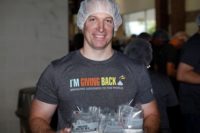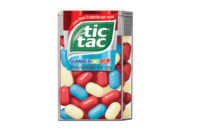Tesco's U.S. Invasion
By Clive Beddall
A formidable new convenience competitor is arriving in America this month, and everyone is — or should be — watching closely.
He is modest and unassuming. But to millions of British shoppers, not to mention grocery gurus around the globe, he is the supermarket boss with the Midas touch. And he is setting up shop in America.
Sir Terry Leahy, the most powerful figure in retailing
in Great Britain, is finally coming to the United States to conquer what he
calls the underinvested part of the American food retail market — the
specialist convenience sector. The ultra-ambitious 51-year-old chief
executive officer of the $84.9-billion Tesco Group, the world’s
third-largest supermarket firm by sales after Wal-Mart and Carrefour of
France, will this month open for business in California, as the United
States becomes the latest platform for his bid to dominate world food
retailing.
The chain plans to open about 100 stores in California,
Arizona and Nevada in coming months, with the first six slated to open
their doors this month in Southern California.
The Tesco story is impressive by any standards.
The chain has always followed the trading maxim of “piling it high
and selling it cheap,” and nowadays takes one in every eight sterling
pounds spent by Britons on groceries. Thus it commands a UK market share of
more than 30 percent — twice the size of its nearest competitor, the
Wal-Mart-owned Asda superstore chain.
Leahy arrives in the United States with an
excellent European business pedigree that has most recently seen him
elevated to the elite group of industry bigwigs who sit as advisors to new
British Prime Minister Gordon Brown.
And as the man behind the Tesco colossus, he is
respected for his encyclopedic knowledge of the retail business, not just
in Britain, but also across the world. That’s a trait that already
has helped him spread his wings around mainland Europe as well as the Far
East.
A look back
But then Tesco’s knack of coming up with the
unexpected and introducing new in-store ideas long before their rivals, has
been evident ever since the chain was founded nearly 80 years ago amid the
street markets of London’s working class East End.
Its originator, the late Sir John (“Jack”)
Cohen, is a business legend in world supermarketing circles. He pioneered the self-service grocery system in Britain
after founding Tesco Stores as a limited company in 1932. By the 1950s, as
post-war food rationing came to an end, Tesco had about 150 stores and was
beginning to challenge the main street dominance of already established
British chains.
But as the supermarket revolution moved into Britain
from the United States, so Cohen was quick to adapt his units, and his
first supermarket opened in 1956. Today the group has 1,988 UK stores, with
nearly 80 percent of its sales and profits coming from the British
business.
It has four different trading formats in the
United Kingdom. The Express format has sales areas of up to 3,000 square
feet and as many as 7,000 lines in product categories including produce,
liquor and an in-store bakery. Metro is a convenience operation in town and
city-center locations, with from 7,000 square feet to 15,000 square feet of
selling space. Superstores boast between 20,000 square feet and 50,000
square feet of sales space, often with non-food operations including DVDs
and books, and extra.
But as Leahy prepares to woo American shoppers, he is
well aware that, with a couple of notable exceptions, British food
retailers have traditionally steered clear of moving into the over-crowded
U.S. market.
Position change
In an exclusive interview six years ago, Leahy
pointedly talked down the notion that Tesco would ever cross the pond. His
philosophy at that time was to go for growth much nearer home, in mainland
Europe.
However, six years is a very long time in the
international grocery business. Tesco’s arrival in California comes
after months of secret planning as its executives have quietly
criss-crossed the Atlantic to study consumer shopping trends in the United
States. Leahy secretly set up a test store in a warehouse in a suburb of
Los Angeles by using the story that the unit was part of a set for a new
film. And a hand-picked team of 20 senior Tesco executives flew to
California to do forensic-style market research, even sleeping over with
American families to see how they lived and shopped.
Yet while all this was going on, some Tesco
spokespersons continued to deny an interest in the American market. But,
inevitably, as the Tesco team was spotted in California, it became clear
that Leahy was sizing up the opportunities to inject his own new brand of
convenience retailing into the American market under the Fresh & Easy
banner.
The model is expected to be based partly on its smaller
store format, Tesco Express. This has already been a major success in other
parts of the world since it opened its first trial store in London in 1994.
The trading philosophy is simple: offer customers great value, quality and
fresh food close to where they live and work.
But Tesco insiders are whispering that Leahy has
a few surprises up his sleeve when he finally opens for business. For a
start, supplier sources say that the firm has been closely studying sales
trends in the fresh foods sector in California. Indeed, some say that the
new concept will be “partly Tesco and partly in the style of Whole
Foods,” the Austin, Texas-based natural foods retailer that has
recently opened its first major store in the United Kingdom, drawing
massive praise from British grocery experts. Tesco sources, however,
privately throw derision at this description, retorting with the statement
that, “This will be an entirely new Tesco, specially developed for
the American market.”
Leahy admits that one of the tricks Tesco has
used is to “tailor stores to local shoppers and take what we learn
back into the group to improve how we operate.”
A ‘fresh’ new concept
Thus, the California concept, the company insisted in
one of its few public statements prior to the opening, will be unlike
anything ever seen in the U.S. convenience arena. And some believe that the
concept may one day wind up being introduced back on British shores.
It is clear that Leahy has done his homework.
Significantly, he told The Wall Street Journal recently that North America
was a place that rewards innovative retailers, adding, “If you do
something different, you get rewarded for it. And retailing returns in
America are quite good by international standards.”
However, sources close to Leahy and the executive to
whom he has entrusted the new U.S. venture, Tim Mason, also suggest that
there is private admiration within the British group for the new style of
neighbourhood store that Wal-Mart has been perfecting in the United States
during recent years.
However, as one Tesco executive put it to me recently,
“Terry is not a man who is prone to copying anything.” At this
stage, perhaps inevitably, the British group is saying nothing about the
pricing policy of the Fresh & Easy concept. But insiders say it will
follow “good value” principles, without resorting to the rock
bottom philosophies of Wal-Mart, for example.
Significantly, there are strong suggestions that half
the goods on sale will be Fresh & Easy private label products —
without trans-fats, artificial colors or flavors — and Tesco will
make extensive use of green technology.
It is expected that the units will, initially, be
around 10,000 square feet, will stock about 3,000 products and, to use
Mason’s words, “be American stores designed for American
consumers.”
Prototype preview
But it’s the way Leahy will merge the
“American way” with the experience gained in his home market
that was intriguing grocery analysts in advance of the California opening.
In particular, suggestions that the Fresh & Easy
stores will sell a range of preservative-free “ready meals” are
arousing keen speculation among experts on both sides of the Atlantic.
United Kingdom supermarkets, unlike their U.S. counterparts, operate on a
small, crowded group of islands with restrictive planning laws. Although
their U.S. cousins efficiently move goods hundreds of miles and keep them
cheap, British chains have became adept at making regular, frequent
deliveries to city-center stores. In other words, their supply chains have
to remain sophisticated and able, for example, to switch from selling
sandwiches at lunch breaks to selling “ready-meal” suppers in
late afternoon.
British retailers have sought economies of scale from
centralized food preparation. This has seen the introduction of more and
more meal sections in-store, and Tesco, in particular, has developed
product ranges that suit every taste.
The group’s talent for staying one jump ahead of
its rivals is never better illustrated than in innovations with its supply
chain. For example, Tesco has trucks with internal partitions for frozen,
chilled and ordinary ambient goods. This enables the company to replace
three deliveries with one, allowing it to sell groceries profitably in
smaller stores at supermarket prices.
Club Tesco
But Tesco’s greatest single innovation might be
its Clubcard loyalty program. While many world retailers merely use
customer clubs to provide a discount to shoppers as they pay for goods, the
Tesco scheme tracks every purchase, and thus builds one of the
world’s largest databases. This finds correlations between purchases,
allowing Tesco to fine tune the product range in-store to suit particular
local needs.
Clubcard is the UK’s most popular loyalty card
plan with more than 11 million active cardholders, and there are more than
80,000 different combinations of offers with each Clubcard mailing.
Meanwhile, although Tesco has delivered a robust
performance in recent years, and there is much to suggest it is a business
primed for further growth, like other UK supermarkets, it faces challenges
in the months ahead.
Britain’s Competition Commission has, for
the past two years, taken a detailed look at the whole UK grocery market.
This probe has included supermarkets’ pricing policies, their
relationships with suppliers and their strategies for opening new stores.
Campaign groups have argued that the dominance of
British supermarkets and Tesco, in particular, allow them to drive smaller
businesses out of some towns. The supermarkets have countered by saying
that they are simply pushing down prices to reflect consumers’ demand
for cheaper food.
The Commission has gathered evidence from a wide area
and is set to report its findings in February 2008.
Coincidentally, in June 2005, the Tescopoly Alliance
was formed. This is a group that represents a diverse list of bodies from
large international non-governmental organizations to unions and small
pressure groups, embracing a range of issues from home workers’
rights to the decline in small, independent retailers.
Its main aim is to challenge what it calls the negative
impact of Tesco’s behavior along its supply chains, both in the UK
and internationally, on small businesses, communities and the environment.
However, despite allegations that some chains have
proved to be heavy-handed negotiators with suppliers (particularly the
smaller ones), grocery analysts believe it unlikely that the Commission
will penalize the store groups.
A Tesco spokesperson puts it like this: “We are
the UK’s No. 1 retailer because we listen and respond to customers
and their changing lifestyles. Rather than developing products and services
that we think customers want, we spend lots of time and effort asking them.
It’s simple. We listen and respond, providing customers with what
they tell us they want.”
And Tesco executives are quick to tell you that that
will continue to be their policy as they set foot in the United States for
the first time.
Clive Beddall is a former editor of the UK’s
largest food business weekly, The Grocer. He was with the magazine for 40 years, 10 of them as
editor-in-chief. He has covered food issues on every continent, and in 2003
was awarded the Order of the British Empire medal (OBE) by Queen Elizabeth
for services to food journalism.
Tesco a Major Player in Confections
Tesco is easily the biggest retail player in the
£4.1 billion UK confectionery market, and its expertise in the sector
is leading to many predictions that it will seek to replicate this
dominance after it opens in the United States this month.
According to the TNS Worldpanel, in the 52 weeks up to
June 17, 2007, Tesco held 32.4 percent of the UK market, compared to its
nearest rival, the Wal-Mart-owned Asda chain, with 17 percent.
However, despite this sales dominance, UK experts say
that the overall sector is in decline as fewer British shoppers are buying
confectionery and existing ones are shopping less frequently.
Key factors are the growing obesity debate in Britain
and a television watchdog’s ban on so-called junk food advertising
during television shows aimed at children under the age of 16.
Nevertheless, confectionery is still one of the biggest
grocery categories in the UK, and major suppliers cite Tesco as one of the
major drivers of product innovation over the years.
The growing healthy eating debate in Britain has led to
many supplier-retailer partnerships that are designed to devise ways of
helping shoppers understand how confectionery can fit into a balanced diet.
Three manufacturers, for example, Cadbury Trebor
Bassett, Masterfoods and Nestlé Rowntree have invested heavily in
creating front-of-pack logos to point consumers in the direction of a panel
showing guideline daily amounts (GDAs) for calories, sugar, fat and salt.
Tesco has been the pioneer of GDAs across the UK retail
market, and a feature of the trade in recent months has seen the allocation
of part of the confectionery fixture to healthier products as well as
implementing a clear signage policy.
Meanwhile, more U.S. manufacturers have been
introducing their brands into the UK market. A significant feature has been
the arrival of Jelly Belly, which has displayed strong credentials in a
climate of celebrity culture. In addition, American candy brand Mike and
Ike also launched in Britain last year and has rapidly developed a
marketing initiative for “all fat-free candies bursting with fruit
flavours.”
At this stage, Tesco is saying nothing about its likely
involvement with confectionery in the new Fresh & Easy stores in
California. But a leading supplier told me that the supermarket’s
pioneering work in healthier products, given the special challenges in the
UK, would stand it in good stead in the United States.



